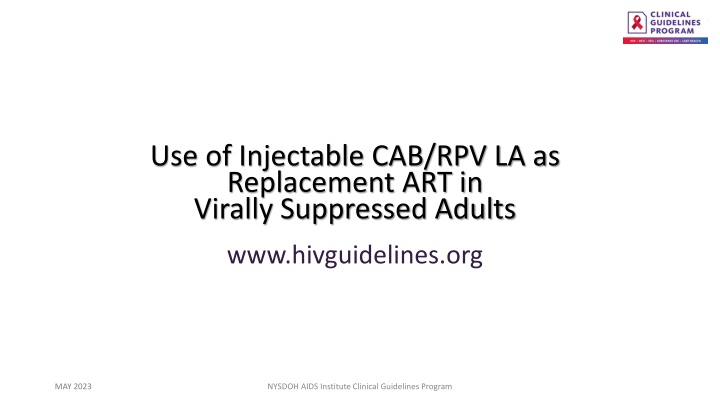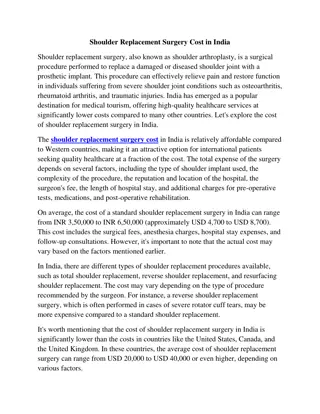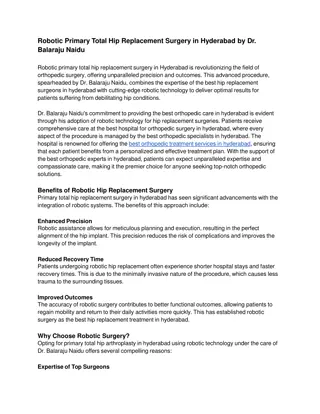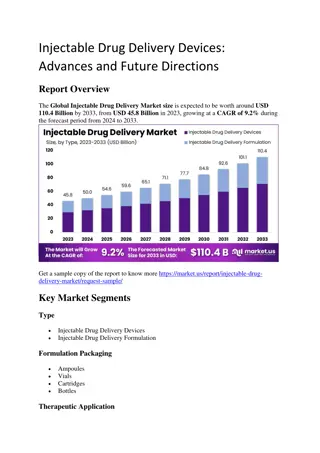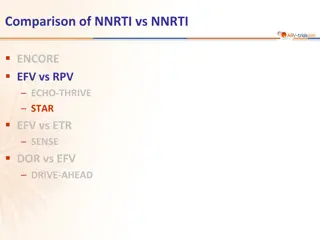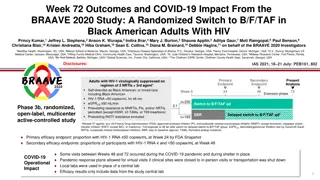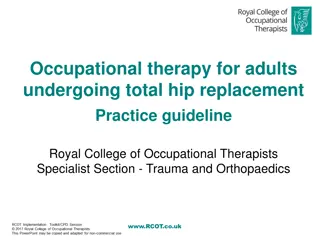Use of Injectable CAB/RPV LA as Replacement ART in Virally Suppressed Adults
This resource discusses the utilization of Injectable CAB/RPV LA as an alternative antiretroviral therapy in adults who are virally suppressed. It provides insights and recommendations from the NYSDOH AIDS Institute Clinical Guidelines Program, offering valuable information for healthcare professionals and individuals living with HIV.
Download Presentation

Please find below an Image/Link to download the presentation.
The content on the website is provided AS IS for your information and personal use only. It may not be sold, licensed, or shared on other websites without obtaining consent from the author.If you encounter any issues during the download, it is possible that the publisher has removed the file from their server.
You are allowed to download the files provided on this website for personal or commercial use, subject to the condition that they are used lawfully. All files are the property of their respective owners.
The content on the website is provided AS IS for your information and personal use only. It may not be sold, licensed, or shared on other websites without obtaining consent from the author.
E N D
Presentation Transcript
Use of Injectable CAB/RPV LA as Replacement ART in Virally Suppressed Adults www.hivguidelines.org MAY 2023 NYSDOH AIDS Institute Clinical Guidelines Program
Purpose of This Guideline Purpose of This Guideline Weigh the risks and benefits of switching from an oral to an injectable ART regimen Engage patients in informed, shared decision-making regarding a switch to injectable ART Choose, initiate, and maintain a monthly (every 4 weeks) or bimonthly (every 8 weeks) dosing schedule, respond to missed doses, and manage discontinuation of injectable ART when indicated Develop medical practice protocols and procedures for implementing injectable ART MAY 2023 NYSDOH AIDS Institute Clinical Guidelines Program www.hivguidelines.org
Recommendations: Recommendations: Patients for Whom CAB/RPV LA is Not Recommended Patients for Whom CAB/RPV LA is Not Recommended Before recommending a switch to CAB/RPV LA, clinicians should determine patients hepatitis B status (hepatitis B surface antigen, core antibody, surface antibody, and HBV DNA if indicated); CAB/RPV LA should not be recommended for patients with active HBV coinfection (defined as having a positive hepatitis B surface antigen or HBV DNA test result) without concurrent oral therapy for HBV. (A*) Clinicians should not recommend CAB/RPV LA in patients with known or suspected INSTI or NNRTI RAMs, excluding the K103N mutation in isolation, at baseline. (A1) Before recommending CAB/RPV LA, clinicians should review results of prior resistance testing and ART treatment history, including all reasons for ART modification. (A3) Preexisting CAB and RPV RAMs have been associated with virologic failure; therefore, clinicians should obtain proviral DNA genotypic resistance testing that includes both the reverse transcriptase and integrase genes before switching to CAB/RPV LA in any patient for whom historical resistance test results are not available or if sustained viral suppression is not documented. (A2) Because there are no currently available data on the safety and efficacy of this regimen in children or adolescents or during pregnancy or breastfeeding, clinicians should not recommend treatment with CAB/RPV LA for these patients. (A*) MAY 2023 NYSDOH AIDS Institute Clinical Guidelines Program www.hivguidelines.org
Benefits and Risks of CAB/RPV LA Benefits and Risks of CAB/RPV LA Benefits: Improved patient satisfaction Monthly (every 4 weeks) or bimonthly (every 8 weeks) administration Directly observed Noninferior to oral antiretroviral therapy (ART) Potential option for patients who have ongoing substance use, mental health concerns, neurocognitive disorders, disclosure concerns, or other challenges associated with adherence to oral ART, including difficulty swallowing pills Removes the daily reminder of HIV status that is associated with taking pills Potential Risks: Potential injection site reactions and other adverse effects, including pyrexia Potential for resistance to develop if doses are missed outside the 7-day window period, given the long half-life ( tail ) of CAB and RPV MAY 2023 NYSDOH AIDS Institute Clinical Guidelines Program www.hivguidelines.org
Limitations of CAB/RPV LA Limitations of CAB/RPV LA Cannot be used if a patient has prior resistance to integrase strand transfer inhibitors or nonnucleoside reverse transcriptase inhibitors, excluding the K103N mutation in isolation Lack of data on use during pregnancy or breastfeeding and in children and adolescents Does not treat hepatitis B virus coinfection Lack of data on use in patients with prior virologic failure Treatment with 4 weeks of oral CAB and RPV (oral lead-in) may be used before the first injection to assess for unexpected reactions or allergies to CAB or RPV Requires oral medications as bridging therapy when injections are missed Medication storage requirements (2 C to 8 C [36 F to 46 F]) Requires 6 to 12 in-person visits with a healthcare provider per year MAY 2023 NYSDOH AIDS Institute Clinical Guidelines Program www.hivguidelines.org
Recommendations: Recommendations: Administration and Dosing Strategy Administration and Dosing Strategy CAB/RPV LA should be administered by a licensed and trained healthcare professional. (A*) To prepare and administer CAB/RPV LA, clinicians should follow the protocols detailed in Preparation and Administration of Initial and Maintenance Doses of Injectable CAB/RPV LA and in the medication package inserts. (A1) If an oral lead-in is chosen to assess medication tolerability, the clinician should prescribe up to 4 weeks of oral CAB/RPV. (A3) Once a dosing schedule is decided upon, clinicians should administer CAB/RPV LA as detailed in the full guideline; a bimonthly (every 8 weeks) dosing schedule is preferred. (A1) MAY 2023 NYSDOH AIDS Institute Clinical Guidelines Program www.hivguidelines.org
MONTHLY (every 4 weeks) CAB/RPV LA Dosing MONTHLY (every 4 weeks) CAB/RPV LA Dosing Timing Dosing and Administration Comments Optional oral lead-in: Therapy initiation: Week 0 (aka month 0) CAB 30 mg/RPV 25 mg once daily by mouth with a meal x 4 weeks Oral medication lead-in Week 4 (aka month 1) CAB 600 mg (3 mL)/RPV 900 mg (3 mL) IM injection Initiation dose: Administer on last day of oral lead-in or prior suppressive ART regimen Week 8 (aka month 2) and every 4 weeks (aka every 1 month) thereafter CAB 400 mg (2 mL)/RPV 600 mg (2 mL) IM injection Maintenance dose: Administer within 7 days before or after scheduled date MAY 2023 NYSDOH AIDS Institute Clinical Guidelines Program www.hivguidelines.org
BIMONTHLY (every 8 weeks) CAB/RPV LA Dosing BIMONTHLY (every 8 weeks) CAB/RPV LA Dosing Timing Dosing and Administration Comments Optional oral lead-in: Therapy initiation: Week 0 (aka month 0) CAB 30 mg/RPV 25 mg once daily by mouth with a meal x 4 weeks Oral medication lead-in Week 4 (aka month 1) CAB 600 mg (3 mL)/RPV 900 mg (3 mL) IM injection Initiation dose: Administer on last day of oral lead-in or prior suppressive ART regimen Week 8 (aka month 2) CAB 600 mg (3 mL)/RPV 900 mg (3 mL) IM injection Maintenance dose: Administer within 7 days before or after scheduled date Week 16 (aka month 4) and every 8 weeks (aka every 2 months) thereafter CAB 600 mg (3 mL)/RPV 900 mg (3 mL) IM injection Maintenance dose: Administer within 7 days before or after scheduled date MAY 2023 NYSDOH AIDS Institute Clinical Guidelines Program www.hivguidelines.org
Advantages and Limitations of Advantages and Limitations of CAB/RPV LA Dosing Strategies CAB/RPV LA Dosing Strategies Advantage or Limitation Monthly (every 4 weeks) Dosing Bimonthly (every 8 weeks) Dosing Required annual visits 12 6 Injection site pain Less More Confirmed virologic failure despite on-time dosing Rare Rare Risk of CAB and/or RPV resistance- associated mutations if confirmed virologic failure Common Common Patient satisfaction High Preferred Staffing, administration time, and cost More Less MAY 2023 NYSDOH AIDS Institute Clinical Guidelines Program www.hivguidelines.org
Preparation and Administration of Initial and Preparation and Administration of Initial and Maintenance Doses of Injectable CAB/RPV LA Maintenance Doses of Injectable CAB/RPV LA 1. Bring the vials [a] of CAB LA and RPV LA to room temperature for at least 15 minutes and for a maximum of 6 hours. 2. Prepare 2 syringes [a]. Once CAB/RPV LA has been drawn into the syringes, they must be used within 2 hours. 3. For aspiration, use a vial adaptor or general-use sterile 21 gauge 1 inch hypodermic needle [b]. Shake the vial vigorously for at least 10 seconds before aspiration. 4. For injection, use a general-use sterile 23 gauge 1 inch hypodermic needle [b]. Administer the injection within 2 hours of syringe preparation. A patient s build or body mass index may be considered when selecting an appropriate injection needle length. 5. Inject into the gluteus medius muscle [c] at a 90 angle, ventrogluteal (preferred) or dorsogluteal (upper-outer quadrant of the buttock), with care that the compound is not injected into a vein. Notes: a. The same preparation and administration are used for both initial and maintenance doses of CAB/RPV LA. Follow sterile technique at all points while preparing syringes and injecting compounds. Use 3 mL vials/syringes for the initial dose and 2 mL vials/syringes for maintenance doses. The hypodermic needle must be long enough to inject the medication into the muscle mass without penetrating underlying nerves, blood vessels, or bone. Inject CAB LA into the gluteus medius muscle and RPV LA into the contralateral gluteus medius muscle. Injections can be given on opposite sides or on the same side, 2 cm apart. b. c. MAY 2023 NYSDOH AIDS Institute Clinical Guidelines Program www.hivguidelines.org
Recommendations: Recommendations: Managing Missed Injections Managing Missed Injections If a patient plans to miss or delay a monthly CAB/RPV LA injection by >7 days, the clinician should arrange for oral medication (CAB 30 mg and RPV 25 mg daily) to be available in advance in an adequate supply (up to 2 months/8 weeks) to cover the gap in injections. Clinicians should resume CAB/RPV LA in patients who miss injections as detailed in the full guideline. (A3) MAY 2023 NYSDOH AIDS Institute Clinical Guidelines Program www.hivguidelines.org
Recommendations: Recommendations: Discontinuing CAB/RPV LA Discontinuing CAB/RPV LA Clinicians should discontinue CAB/RPV LA in patients with confirmed virologic failure (defined as 2 consecutive plasma HIV-1 RNA measurements 200 copies/mL) or evidence of INSTI or NNRTI RAMs, excluding the K103N mutation in isolation, on subsequent genotype testing. (A1) Clinicians should discontinue CAB/RPV LA in patients with evidence of INSTI or NNRTI RAMs (excluding the K103N mutation in isolation) on subsequent proviral DNA-based genotype testing (which may be performed for another clinical indication or following a viral blip), regardless of viral load suppression status, including an undetectable viral load (defined as plasma HIV-1 RNA measurement <50 copies/mL). (B3) When extended or frequent gaps occur between injections, resulting in prolonged periods of subtherapeutic drug concentrations, the risk of drug resistance increases; to avoid this risk, clinicians should encourage patients to adhere to the injection schedule and should switch to oral therapy for patients who cannot maintain the injection schedule. (A3) If CAB/RPV LA is discontinued, the clinician should initiate a fully suppressive oral ART regimen no later than 1 month (4 weeks) following the final CAB/RPV LA monthly injection or 2 months (8 weeks) following final CAB/RPV LA bimonthly injection. (A2) MAY 2023 NYSDOH AIDS Institute Clinical Guidelines Program www.hivguidelines.org
Recommendation: Recommendation: Laboratory Testing and Monitoring Laboratory Testing and Monitoring Clinicians should perform baseline and routine monitoring of patients receiving injectable ART according to the recommendations in the following NYSDOH AI guidelines (A3): Virologic and Immunologic Monitoring in HIV Care and Laboratory Monitoring for Adverse Effects of ART. Good Practice: Follow up by phone within 1 week after initiation of oral therapy lead-in, if used, and within 3 days after a patient receives the initial loading dose of injectable ART to assess the patient s tolerance. MAY 2023 NYSDOH AIDS Institute Clinical Guidelines Program www.hivguidelines.org
Institutional and Clinical Preparations for Institutional and Clinical Preparations for Implementation of Injectable ART Implementation of Injectable ART Assess pharmacy resources and on-site procedures for storage of oral and injectable medications Train nurses and other medical care providers regarding proper syringe preparation and injection techniques Establish billing protocols for the procurement and administration of injectable ART medications Implement a system to remind patients of appointments Plan for treatment continuation in the event of pandemic-related shutdowns or other catastrophic events Provide education on the use of oral bridging therapy Educate patients about possible adverse effects associated with injectable long-acting cabotegravir/rilpivirine and how to manage them Ensure that patients know how to reach a medical care provider if needed Schedule appointments for administration in advance MAY 2023 NYSDOH AIDS Institute Clinical Guidelines Program www.hivguidelines.org
Patient Preparations for Patient Preparations for Implementation of Injectable ART Implementation of Injectable ART Obtain prior authorizations for insurance or third-party coverage of ART medications Confirm ability to maintain required clinic visit schedule for injections, including transportation availability Confirm ability to adhere to the injection regimen Confirm ability to tolerate 2 large volume intramuscular injections regularly MAY 2023 NYSDOH AIDS Institute Clinical Guidelines Program www.hivguidelines.org
Need Help? Need Help? NYSDOH AIDS Institute Clinical Guidelines Program www.hivguidelines.org
Access the Guideline Access the Guideline www.hivguidelines.org > Use of Injectable CAB/RPV LA as Replacement ART in Virally Suppressed Adults Also available: Printable pocket guide and PDF NYSDOH AIDS Institute Clinical Guidelines Program www.hivguidelines.org
